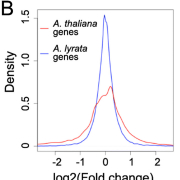In Genome Biology: 3D genome of interspecific hybrids
Altered chromatin compaction & histone methylation in an interspecific Arabidopsis hybrid
Wangsheng Zhu et al., Genome Biology 2017 18:157, doi.org/10.1186/s13059-017-1281-4
Background: The merging of two diverged genomes can result in hybrid offspring that phenotypically differ greatly from both parents. In plants, interspecific hybridization plays important roles in evolution and speciation. In addition, many agricultural and horticultural species are derived from interspecific hybridization. However, the detailed mechanisms responsible for non-additive phenotypic novelty in hybrids remain elusive.
Results: In an interspecific hybrid between Arabidopsis thaliana and A. lyrata, the vast majority of genes that become upregulated or downregulated relative to the parents originate from A. thaliana. Among all differentially expressed A. thaliana genes, the majority is downregulated in the hybrid. To understand why parental origin affects gene expression in this system, we compare chromatin packing patterns and epigenomic landscapes in the hybrid and parents. We find that the chromatin of A. thaliana, but not that of A. lyrata, becomes more compact in the hybrid. Parental patterns of DNA methylation and H3K27me3 deposition are mostly unaltered in the hybrid, with the exception of higher CHH DNA methylation in transposon-rich regions. However, A. thaliana genes enriched for the H3K27me3 mark are particularly likely to differ in expression between the hybrid and parent.
Conclusions: It has long been suspected that genome-scale properties cause the differential responses of genes from one or the other parent to hybridization. Our work links global chromatin compactness and H3K27me3 histone modification to global differences in gene expression in an interspecific Arabidopsis hybrid.




